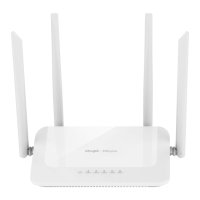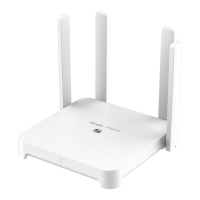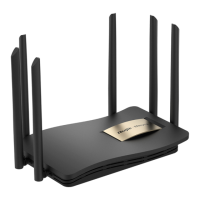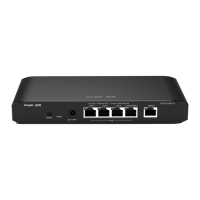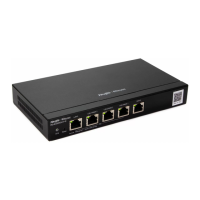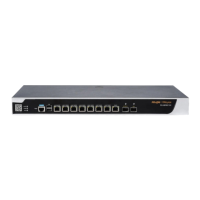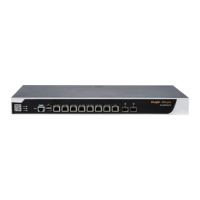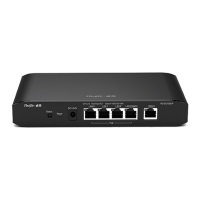Do you have a question about the Ruijie Reyee RG-EW1300G and is the answer not in the manual?
| Router Type | Wireless Router |
|---|---|
| Ethernet Ports | 4 x 10/100/1000 Mbps |
| RAM | 128MB |
| Flash | 16MB |
| MU-MIMO | Yes |
| OFDMA | Yes |
| Beamforming | Yes |
| Wireless Standards | IEEE 802.11a/b/g/n/ac |
| Frequency Bands | 2.4 GHz, 5 GHz |
| Antennas | 4 |
| Operating Temperature | 0°C to 40°C |
| Operating Humidity | 10% to 90% (non-condensing) |
| Power Supply | 12V/1A |
Guides users on how to connect a PC to the router via wired or wireless connections for initial setup.
Explains how to access the router's management page by entering the IP address and logging in.
Describes the two supported Internet access modes: Primary Router Mode and Secondary Router Mode.
Details configuration steps for the primary router mode, including connection types and initial setup.
Provides instructions for setting up the router in secondary mode, covering wired and wireless connections.
Explains how to extend Wi-Fi coverage by pairing routers using the Mesh button or management page.
Instructions for modifying the Wi-Fi network name (SSID) and security password for enhanced network security.
Details on hiding the Wi-Fi network name to prevent unauthorized access and improve overall network security.
Guides on enabling band steering to allow clients to automatically connect to the optimal Wi-Fi band for better performance.
Explains how to configure primary, guest, and smart Wi-Fi networks for different user needs and scenarios.
Enables management of client access by blocking or allowing specific MAC addresses to the Wi-Fi network.
Provides methods for optimizing Wi-Fi performance, including channel and bandwidth adjustments for better signal.
Details on enabling healthy mode, which reduces transmit power and Wi-Fi coverage area for potential energy saving.
Guides on setting up the router's internet connection using PPPoE, DHCP, or static IP addressing methods.
Instructions for modifying the IP address and subnet mask of a LAN port for network customization and management.
Explains how to change the MAC address of the WAN or LAN port for security or ISP compatibility requirements.
Details on adjusting the Maximum Transmission Unit (MTU) size to resolve network speed or connectivity issues.
Guides on setting up IPv6 addresses for WAN and LAN ports to support the modern IPv6 network standard.
Provides features to set Internet access schedules and limits for connected devices, ensuring safe browsing.
Enables XPress feature to optimize network traffic for a more stable and faster gaming experience.
Allows mapping of router's WAN ports to internal network devices for external access to services like cameras.
Details on configuring the DHCP server to automatically assign IP addresses to network clients for seamless connectivity.
Explains DNS proxy configuration and default DNS server usage for efficient website name resolution.
Allows configuration of DHCP options, which are applied to all LAN ports for advanced network settings.
Enables access to router services using a fixed domain name without needing a static IP address.
Binds MAC addresses to IP addresses on the LAN to prevent unauthorized device access and enhance network security.
Guides on configuring the router for IPTV services, supporting VLAN and IGMP types for television streaming.
Optimizes multicast streaming for IPTV services by converting packets for wireless clients, reducing congestion.
Improves Internet access speed and client performance by enabling hardware acceleration for data processing.
Details on setting up Reyee Mesh 3.0 for parallel networking and AP networking modes to enhance Wi-Fi coverage.
Guides on setting up routers in AP mode for wired network connectivity and unified management.
Enables CPE WAN Management Protocol for remote centralized management of network devices from the network side.
Intelligently adjusts network speed per user to ensure fair bandwidth distribution and prevent congestion.
Relieves data congestion by controlling traffic at different port speeds for improved overall network performance.
Covers advanced network configurations like enabling the firewall for enhanced device and network security.
Enables Universal Plug and Play for faster and more stable application performance by mapping network ports.
Sets up network connectivity checks with specified intervals and URL lists for monitoring network status.
Allows enabling or disabling the Wi-Fi function on the device via a convenient switch control.
Guides on setting up PPTP VPN server or client for secure branch office connectivity over public networks.
Details on establishing secure virtual private tunnels using OpenVPN in server or client mode for remote access.
Sets the router to Access Point mode using an Ethernet cable for stable Wi-Fi with less interference.
Explains how to extend Wi-Fi coverage by wirelessly connecting the router to a primary router.
Guides on setting up a WLAN for Internet access in public spaces using the Wireless Internet Service Provider mode.
Instructions for switching the display interface from mobile view to PC view for a different layout experience.
Guides on changing the device's login password for enhanced security and access control.
Allows remote management of the device via a URL link for access from outside the local network.
Details on resetting the router to its default factory settings, with an option to preserve native configuration.
Guides on setting the system time, time zone, and configuring NTP servers for accurate timekeeping.
Allows scheduling automatic device reboots on a weekly basis for regular maintenance and stability.
Instructions for checking the current system version and performing online firmware upgrades for the device.
Explains how to turn the device's LED indicators on or off for visual status management.
Guides on changing the system interface language for user preference and easier operation.
Configures alerts for network anomalies and provides suggested actions for troubleshooting and fault prevention.
Provides tools and steps to check network status and identify potential issues for effective troubleshooting.
Offers tools like Ping, Traceroute, and DNS Lookup for detailed network analysis and problem diagnosis.
Allows backup and restoration of router configuration files for easy management, recovery, and migration.
Sets the duration of inactivity before the management session times out, enhancing security.
